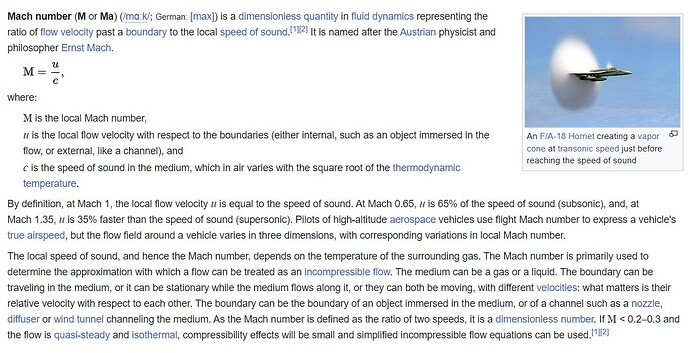I’m trying to understand tables, and how they work.
Please have understanding.
For example, there is a table called the following: drag_coef_zero_lift_mach_tab
The MSFS SDK describes it like this:
Adds drag based on the mach level. In the modern flight model, the drag coefficient at higher mach levels is automatically impacted by a progressive detaching of the laminar airflow over the surfaces. However this table allows to add more drag at specific mach levels to simulate a mach wall or specific effects of drag due to turbulence at specific drag levels. Drag walls are not natively simulated yet and will need to be defined with this table. The table has a maximum of 17 entries and the format:
mach:drag_coef,
mach:drag_coef,
mach:drag_coef,
etc…
Also why do MSFS call it mach level, and not mach number?
The first question is about formatting. How you can or must write the table.
For example. it seems that most flight models have the table formatted in a long line, which makes it very difficult to read. Is there a reason they do it?
Take for example, FBW A320 drag_coef_zero_lift_mach_tab
They have written it like this:
drag_coef_zero_lift_mach_tab = 0:0, 0.5:0, 0.55:0, 0.6:0.0002, 0.65:0.0003, 0.7:0.0004, 0.75:0.0008, 0.8:0.0015, 0.85:0.010, 0.9:0.15, 0.95 :0.333, 1:0.5
The question is then, could it just as well have been written like this:
drag_coef_zero_lift_mach_tab =
0:0,
0.5:0,
0.55:0,
0.6:0.0002,
0.65:0.0003,
0.7:0.0004,
0.75:0.0008,
0.8:0.0015,
0.85:0.010,
0.9:0.15,
0.95:0.333,
1:0.5
Or is there some reason that most aircraft cfg files are formatting the tables in a long unreadable line?
The next question is about the actual numbers:
If I understand correctly the first number is mach speed?
which in FBW’s case becomes mach 0, then mach 0.5, then mach 0.6 and so on.
If I understand this correctly, they have entered these values in the table to increase drag with speed, above drag_coef_zero_lift?
If I then take their value of drag_coef_zero_lift = 0.01873
Can you then say that at mach 0.6, drag will increase by 0.0002?
Which in that case would be 0.01873+0.0002=0.01893
Do I understand this table correctly that at mach speed 0.6 the drag without flaps and wheels"cleean config" will be 0.01893?
Could they have written table like this?
drag_coef_zero_lift_mach_tab =
0:0,
0.5:0,
0.55:0,
0.6:0.0002,
0.65:0.0003,
0.7:0.0004,
0.75:0.0008,
0.8:0.0015,
0.85:0.010,
0.9:0.15,
0.95:0.333,
1:0.5
So if I understand correctly, the most important thing in understanding the tables is what they refer to, or where they remove or add properties.
Is it also correct that most tables have become unusable in “modern flight model”?
Eg: lift_coef_horizontal_incidence_mach_table which if I understand correctly changes the “lift” of lift_coef_horizontal_incidence?
[SDK]
Defines how much lift will be added to the overall lift formula based on the current yaw angle of the aircraft.
This is a legacy FSX parameter not used in the modern flight model. In the modern flight model this effect is natively obtained through aerodynamic simulation of the surfaces defined in the [AIRPLANE_GEOMETRY] section.
In the FBW flight model they have included this parameter, but set it as 0? They have also set the corresponding table as 0.
(lift_coef_horizontal_incidence_mach_table = 0:0)
Do you have to include parameters that are not used by e.g. modern flight models?
Do you have to write 0:0 or is it enough to write only =
Then I come to the next question. If I’m not wrong, e.g. PMDG uses modern flight model. Then the question is why have they included a parameter that is not used by modern flight models.
They have, for example:
lift_coef_horizontal_incidence=1.891602
lift_coef_horizontal_incidence_mach_table=0.000000:0.000000, 0.200000:0.003908, 0.400000:0.009770, 0.600000:0.040059, 0.800000:0.160234, 1.000000:0.08 2071, 1.200000:0.048852, 1.400000:0.048852, 1.600000:0.047875, 1.800000:0.048852, 2.000000:0.047875, 2.200000:0.048852, 2.400000:0.048852, 2.600000:0.048852, 2.800000:0.048852, 3.000000:0.047875, 3.200000:0.048852
For example, they have defined the aircraft as:
modern_fm_only=1
This should mean that none of these lines have any effect on how the aircraft behaves?
I understand that no one but them can answer why they have done so.
But is there something I’m missing. Should they have done like FBW and just put 0?
I think they might use these in case they become relevant. Or to remember aircraft behavior.
But when you construct an aircraft model, what is the correct way to do it? FBW or PMDG style?
Many questions, very grateful for answers.
